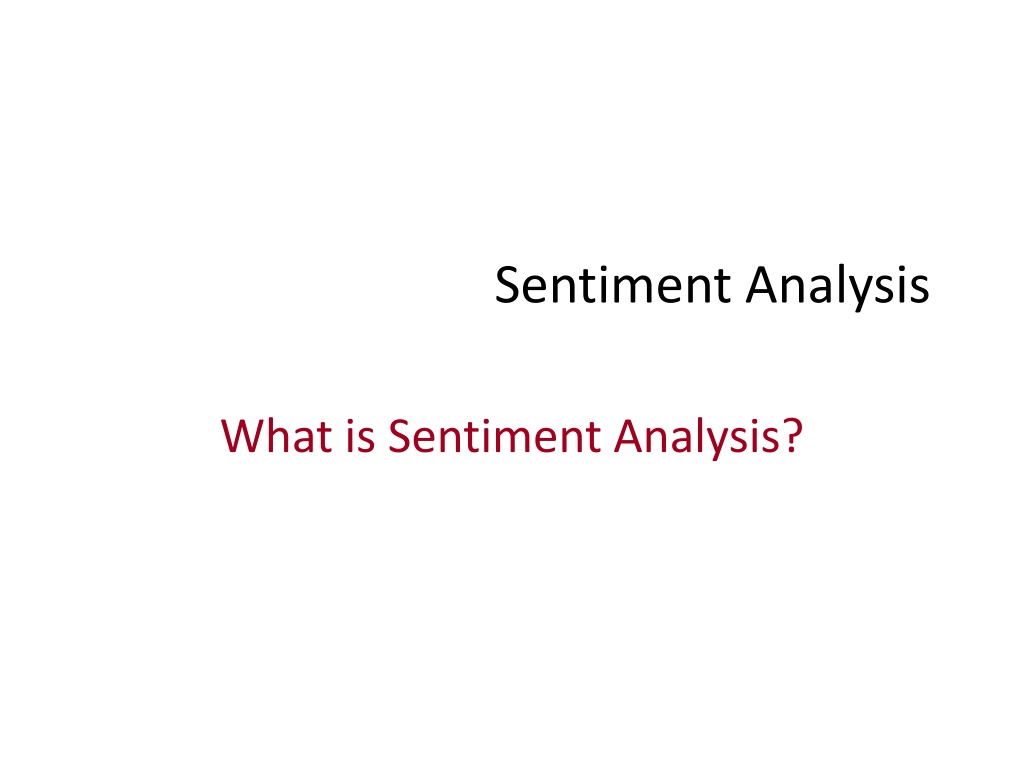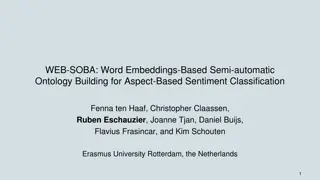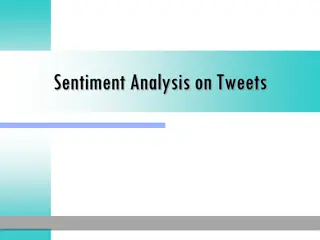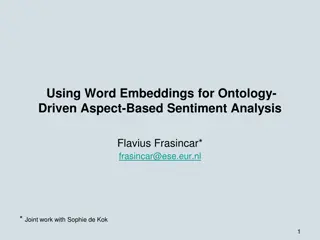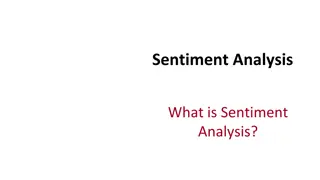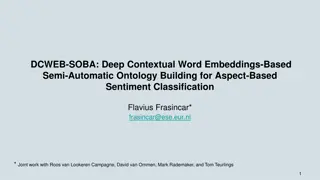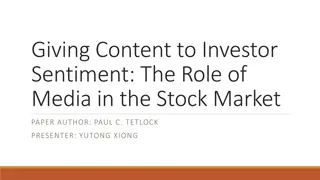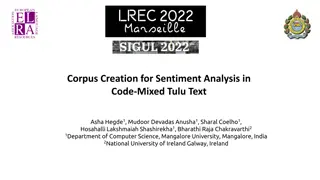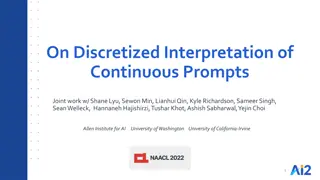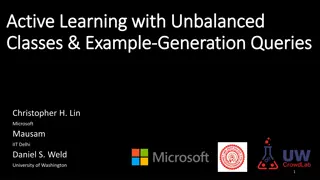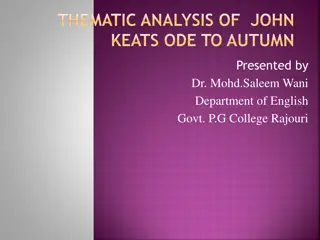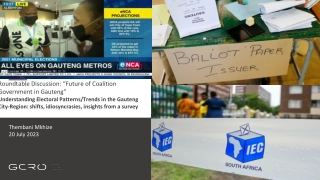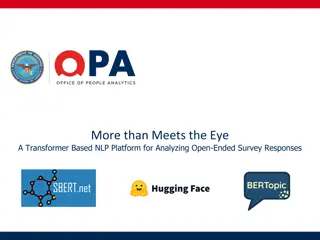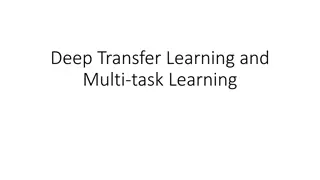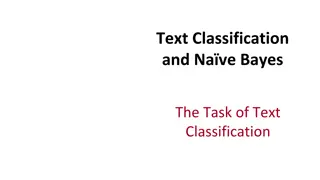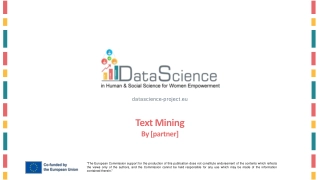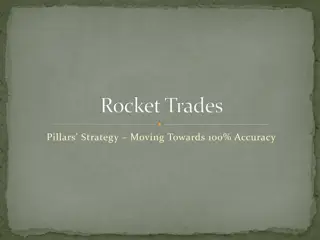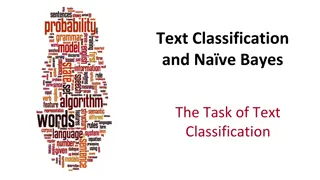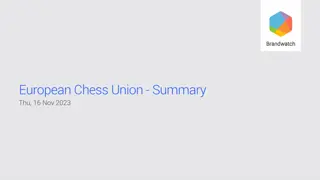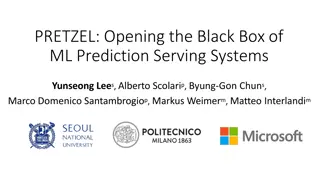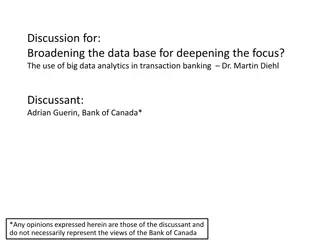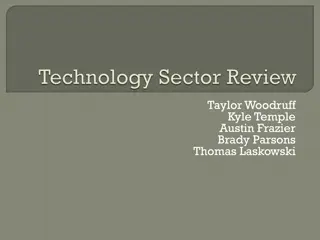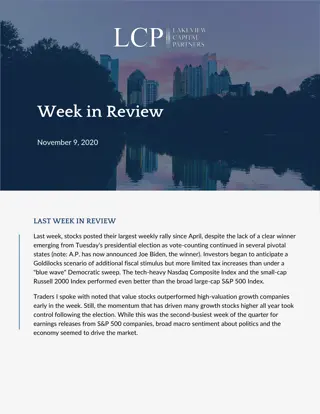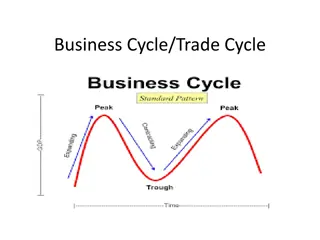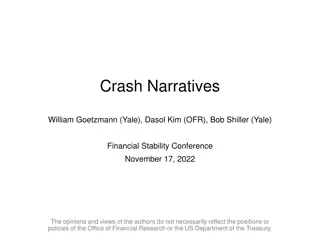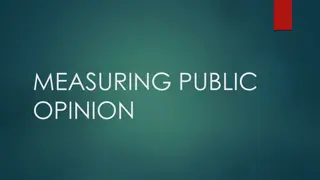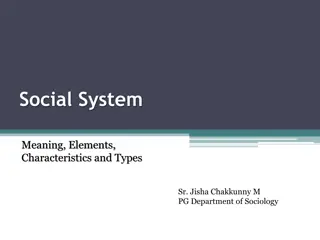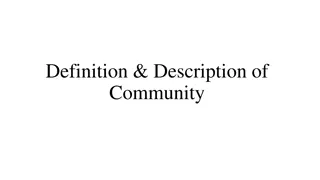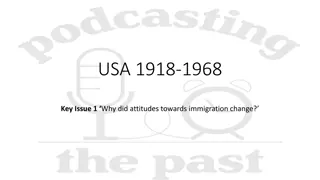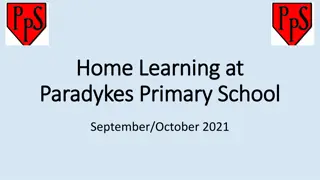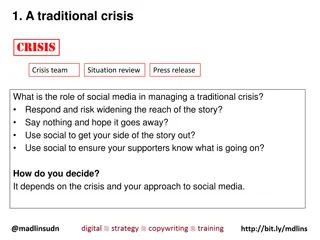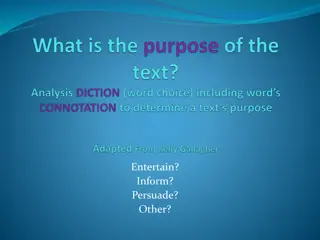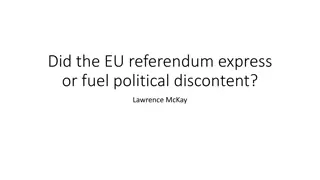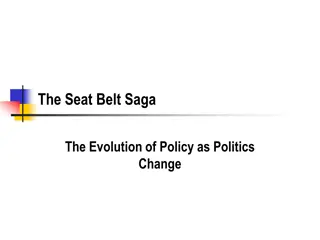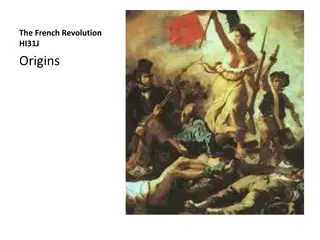Understanding Sentiment Analysis: A Comprehensive Overview
Sentiment analysis, also known as opinion mining, is the process of evaluating written or spoken language to determine the positivity, negativity, or neutrality of the expression. It involves the systematic identification, extraction, and study of affective states and subjective information using natural language processing and computational linguistics. This analysis plays a crucial role in understanding public opinion and sentiment towards various topics, products, or services. Different studies have linked sentiment analysis to areas such as stock market prediction and consumer confidence polls.
Download Presentation

Please find below an Image/Link to download the presentation.
The content on the website is provided AS IS for your information and personal use only. It may not be sold, licensed, or shared on other websites without obtaining consent from the author. Download presentation by click this link. If you encounter any issues during the download, it is possible that the publisher has removed the file from their server.
E N D
Presentation Transcript
Sentiment Analysis What is Sentiment Analysis?
Sentiment Analysis Sentiment analysis is the measurement of positive and negative language. It is a way to evaluate written or spoken language to determine if the expression is favorable, unfavorable, or neutral, and to what degree. Opinion mining/sentiment analysis/emotion AI refers to the use of natural language processing, text analysis and computational linguistics to systematically identify, extract, quantify, and study affective states and subjective information. 2
Sentiment Analysis The process of computationally identifying and categorizing opinions expressed in a piece of text, especially in order to determine whether the writer's attitude towards a particular topic, product, etc. is positive, negative, or neutral. Positive or negative movie review?: unbelievably disappointing Full of zany characters and richly applied satire, and some great plot twists this is the greatest screwball comedy ever filmed It was pathetic. The worst part about it was the boxing scenes.
Bing Shopping a 5
Twitter sentiment versus Gallup Poll of Consumer Confidence Brendan O'Connor, Ramnath Balasubramanyan, Bryan R. Routledge, and Noah A. Smith. 2010. From Tweets to Polls: Linking Text Sentiment to Public Opinion Time Series. In ICWSM-2010
Twitter sentiment: Johan Bollen, Huina Mao, Xiaojun Zeng. 2011. Twitter mood predicts the stock market, Journal of Computational Science 2:1, 1-8. 10.1016/j.jocs.2010.12.007. 7
Target Sentiment on Twitter Twitter Sentiment App Alec Go, Richa Bhayani, Lei Huang. 2009. Twitter Sentiment Classification using Distant Supervision 8
Sentiment analysis has many other names Opinion extraction Opinion mining Sentiment mining Subjectivity analysis 9
Why sentiment analysis? Movie: is this review positive or negative? Products: what do people think about the new iPhone? Public sentiment: how is consumer confidence? Is despair increasing? Politics: what do people think about this candidate or issue? Prediction: predict election outcomes or market trends from sentiment 10
Sentiment Analysis Sentiment analysis is the detection of attitudes Attitudes: enduring, affectively colored beliefs, dispositions towards objects or persons liking, loving, hating, valuing, desiring 1. Holder (source) of attitude 2. Target (aspect) of attitude 3. Type of attitude From a set of types Like, love, hate, value, desire, etc. Or (more commonly) simple weighted polarity: positive, negative, neutral, together with strength 4. Text containing the attitude Sentence or entire document
Sentiment Analysis Simplest task: Is the attitude of this text positive or negative? More complex: Rank the attitude of this text from 1 to 5 Advanced: Detect the target, source, or complex attitude types
Sentiment Analysis Simplest task: Is the attitude of this text positive or negative? More complex: Rank the attitude of this text from 1 to 5 Advanced: Detect the target, source, or complex attitude types
Sentiment Analysis A Baseline Algorithm
Sentiment Classification in Movie Reviews Bo Pang, Lillian Lee, and Shivakumar Vaithyanathan. 2002. Thumbs up? Sentiment Classification using Machine Learning Techniques. EMNLP-2002, 79 86. Bo Pang and Lillian Lee. 2004. A Sentimental Education: Sentiment Analysis Using Subjectivity Summarization Based on Minimum Cuts. ACL, 271-278 Polarity detection: Is an IMDB movie review positive or negative? Data: Polarity Data 2.0: http://www.cs.cornell.edu/people/pabo/movie-review-data
IMDB data in the Pang and Lee database when _star wars_ came out some twenty years ago , the image of traveling throughout the stars has become a commonplace image . [ ] snake eyes is the most aggravating kind of movie : the kind that shows so much potential then becomes unbelievably disappointing . it s not just because this is a brian depalma film , and since he s a great director and one who s films are always greeted with at least some fanfare . and it s not even because this was a film starring nicolas cage and since he gives a bravura performance , this film is hardly worth his talents . when han solo goes light speed , the stars change to bright lines , going towards the viewer in lines that converge at an invisible point . cool . _october sky_ offers a much simpler image that of a single white dot , traveling horizontally across the night sky . [. . . ]
Baseline Algorithm (adapted from Pang and Lee) Tokenization Feature Extraction Classification using different classifiers Na ve Bayes MaxEnt SVM
Sentiment Tokenization Issues Deal with HTML and XML markup Twitter mark-up (names, hash tags) Capitalization (preserve for words in all caps) Phone numbers, dates Emoticons Useful code: Christopher Potts sentiment tokenizer Brendan O Connor twitter tokenizer Potts emoticons [<>]? # optional hat/brow [:;=8] # eyes [\-o\*\']? # optional nose [\)\]\(\[dDpP/\:\}\{@\|\\] # mouth | #### reverse orientation [\)\]\(\[dDpP/\:\}\{@\|\\] # mouth [\-o\*\']? # optional nose [:;=8] # eyes [<>]? # optional hat/brow 18
Extracting Features for Sentiment Classification How to handle negation I didn t like this movie vs I really like this movie Which words to use? Only adjectives All words All words turns out to work better, at least on this data 19
Negation Das, Sanjiv and Mike Chen. 2001. Yahoo! for Amazon: Extracting market sentiment from stock message boards. In Proceedings of the Asia Pacific Finance Association Annual Conference (APFA). Bo Pang, Lillian Lee, and Shivakumar Vaithyanathan. 2002. Thumbs up? Sentiment Classification using Machine Learning Techniques. EMNLP-2002, 79 86. Add NOT_ to every word between negation and following punctuation: didn t like this movie , but I didn t NOT_like NOT_this NOT_movie but I
Reminder: Nave Bayes cNB=argmax P(cj) P(wi|cj) cj C i positions P(w|c)=count(w,c)+1 count(c)+ V 21
Binarized (Boolean feature) Multinomial Nave Bayes Intuition: For sentiment (and probably for other text classification domains) Word occurrence may matter more than word frequency The occurrence of the word fantastic tells us a lot The fact that it occurs 5 times may not tell us much more. Boolean Multinomial Na ve Bayes Clips all the word counts in each document at 1 22
Boolean Multinomial Nave Bayes: Learning From training corpus, extract Vocabulary Calculate P(cj)terms For each cj in C do docsj all docs with class =cj Calculate P(wk| cj)terms Remove duplicates in each doc: For each word type w in docj Retain only a single instance of w Textj single doc containing all docsj Foreach word wkin Vocabulary nk # of occurrences of wkin Textj |docsj| P(cj) nk+a P(wk|cj) |total # documents| n+a |Vocabulary|
Boolean Multinomial Nave Bayes on a test document d First remove all duplicate words from d Then compute NB using the same equation: cNB=argmax P(cj) P(wi|cj) cj C i positions 24
Normal vs. Boolean Multinomial NB Normal Training Doc 1 2 3 4 5 Words Chinese Beijing Chinese Chinese Chinese Shanghai Chinese Macao Tokyo Japan Chinese Chinese Chinese Chinese Tokyo Japan Class c c c j ? Test Boolean Training Doc 1 2 3 4 5 Words Chinese Beijing Chinese Shanghai Chinese Macao Tokyo Japan Chinese Chinese Tokyo Japan Class c c c j ? Test 25
Binarized (Boolean feature) Multinomial Na ve Bayes B. Pang, L. Lee, and S. Vaithyanathan. 2002. Thumbs up? Sentiment Classification using Machine Learning Techniques. EMNLP-2002, 79 86. V. Metsis, I. Androutsopoulos, G. Paliouras. 2006. Spam Filtering with Naive Bayes Which Naive Bayes? CEAS 2006 - Third Conference on Email and Anti-Spam. K.-M. Schneider. 2004. On word frequency information and negative evidence in Naive Bayes text classification. ICANLP, 474-485. JD Rennie, L Shih, J Teevan. 2003. Tackling the poor assumptions of naive bayes text classifiers. ICML 2003 Binary seems to work better than full word counts 1---inbetween--- freq Other possibility: log(freq(w)) 26
Cross-Validation Iteration Break up data into 10 folds (Equal positive and negative inside each fold?) For each fold Choose the fold as a temporary test set Train on 9 folds, compute performance on the test fold Report average performance of the 10 runs 1 Test Training 2 Training Test 3 Training Test Training 4 Training Test Training 5 Test
Other issues in Classification MaxEnt and SVM tend to do better than Na ve Bayes 28
Problem: What makes reviews hard to classify? Thwarted Expectations and Ordering Effects This film should be brilliant. It sounds like a great plot, the actors are first grade, and the supporting cast is good as well, and Stallone is attempting to deliver a good performance. However, it can t hold up. Well as usual Keanu Reeves is nothing special, but surprisingly, the very talented Laurence Fishbourne is not so good either, I was surprised. 29
